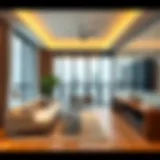Exploring Dubai's Metro: Impact on Urban Transit and Real Estate
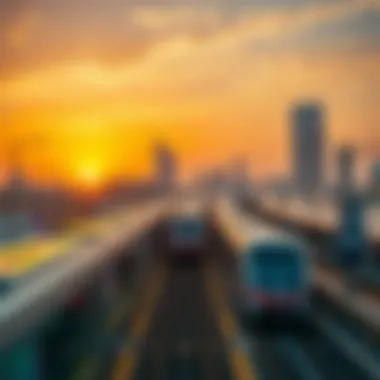

Market Trends
Current Market Analysis
Dubai's urban transit system has undergone remarkable transformation with the inception of its metro. This development has not only increased connectivity across the city, but it has also reshaped the landscape of real estate and urban mobility. With a keen eye on the current market dynamics, it's clear that areas surrounding metro stations are forking out premium prices. Property values in neighborhoods like Dubai Marina and Business Bay are on the rise, benefiting from their proximity to this rapid transit system.
In the latest figures, reports suggest that properties located within a 10-minute walk of a metro station can see as much as a 20% increase in value compared to those farther away. The efficiency of the metro has created a ripple effect, optimizing traffic patterns and reducing congestion, which in turn boosts neighboring property desirability. Investors are keen to leverage this trend, recognizing metro access as a crucial factor in property valuation.
Future Predictions
Looking ahead, the Dubai metro system is set to expand even further, with plans for new routes that will enhance connectivity to key areas such as Dubai Expo 2020 and other upcoming developments. The projected developments indicate that property investments near these future metro lines will likely appreciate significantly. As urban planners emphasize sustainability and public transport, the value of properties linked closely with the metro is expected to skyrocket.
Key indicators for property investment include:
- Planned expansions of the metro network
- Areas becoming business hubs due to improved accessibility
- Increase in population density around metro routes
Real estate experts also forecast a shift in consumer demand towards more eco-friendly and public transport-oriented living arrangements.
"Investing in properties near public transport is a beacon of stability in a fluctuating market." – Long-time Dubai real estate analyst
Property Investment Insights
Types of Investment Properties
Several types of investment properties are increasingly appealing in the landscape influenced by the metro system. Among the most sought-after categories are:
- Residential apartments: High-rises and communities near metro station hubs.
- Commercial spaces: Retail outlets and offices that benefit from high footfall.
- Mixed-use developments: A blend of living and working spaces, aiming at urban dwellers who prefer convenience.
These categories attract a variety of investors, including expatriates and local individuals looking to capitalize on the booming real estate market.
Financing Options and Tips
When it comes to financing property investments tied to the metro system, potential buyers have several options. Traditional banks, specialized lenders, and even some metro developers offer financing solutions tailored for these properties. Potential investors should consider:
- Mortgages tailored for expats: These often have flexible conditions and relatively low interest rates.
- Public funding and subsidies: Various governmental programs can help first-time buyers, making properties more accessible.
- Private equity and investor partnerships: Combining funds with other investors can lower the bar for entry into more lucrative opportunities.
For more comprehensive insights on real estate investment trends, visit Investopedia or explore further on Dubai Land Department.
As the city continues to develop, being informed about the impacts and opportunities presented by the metro system will be key for anyone looking to make the most of Dubai's real estate market.
Overview of Dubai's Metro System
Understanding the framework of Dubai's metro system is like peering into the city’s future, as this intricate network plays a pivotal role in urban transport. The metro serves as a reliable and efficient means of moving millions daily, bridging various neighborhoods and facilitating economic activities across this bustling metropolis.
Historical Context
Dubai’s journey towards a sophisticated metro system began in the early 2000s, when the city rapidly transformed from a trading port into a global hub of tourism and commerce. The first line was inaugurated in 2009, and it represented a significant leap into modern urban transport, driven by both necessity and ambition. The government envisioned something not just functional, but also iconic, showcasing the UAE's commitment to innovation and development.
Key Features of the Metro
Line Structure
The metro lines are thoughtfully designed to cater to the diverse needs of its users. Currently, the network comprises multiple lines that extend over 90 kilometers in total. Each line connects vital areas, including residential neighborhoods, commercial centers, and tourist spots. An outstanding trait is the integration of a driverless system, which not only enhances operational efficiency but also reflects Dubai’s forward-thinking philosophy. This orientation to automation attracts tech-savvy commuters, while the absence of drivers reduces labor costs significantly. Despite these advantages, concerns about the system’s adaptability to peak travel hours have sparked discussions among the authorities and residents alike.
Stations and Accessibility
Dubai’s metro stations exemplify modernity and accessibility. The stations are strategically located, ensuring they are within a reasonable distance for most residents. Features like elevators, ramps, and tactile guidance systems underscore a commitment to making transit inclusive for everyone, catering to individuals with mobility challenges. Each station is equipped with modern amenities, ensuring comfort while waiting for rides. However, while accessibility is a priority, some might find the distance between certain stations a minor inconvenience, especially during the summer months when temperatures soar.
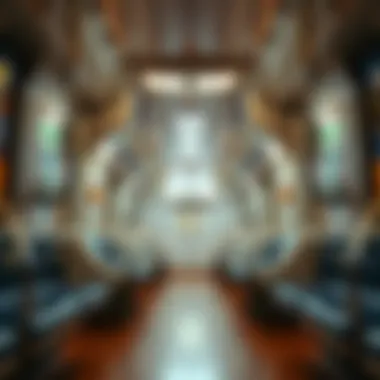

Operational Efficiency
Efficiency is a hallmark of the metro's operations. With a frequency of trains arriving every few minutes, the system can handle a vast number of passengers efficiently. Real-time updates and automated ticketing systems reduce congestion and enhance user experience. Notably, the zoning system for fare structures promotes reasonable pricing, making it an attractive choice for regular commuters. However, some users have raised questions about the reliability of train timings during rush hours, suggesting room for improvement in service frequency.
"An efficient metro system is not just about transportation; it is a catalyst for urban growth and a reflection of the city’s ambitions."
Metro Usage Statistics
Understanding the nuances of metro usage statistics is vital for grasping the full impact of Dubai's urban transit system. These statistics provide insight into how people interact with the metro system, revealing essential trends in commuting and urban mobility. As this article delves into the daily commuter count, seasonal variations, and demographic insights, we can better appreciate the metro's role within the city’s infrastructural framework. The core benefits of analyzing these figures include acknowledging commuter behaviors and informing potential adjustments or enhancements in services, which ultimately contribute to a more effective transit system.
Passenger Trends
Daily Commuter Count
Daily commuter count is a fascinating figure that illustrates how many people rely on the metro for their everyday travel needs. Typically, this count can reach upwards of 700,000 passengers on weekdays, underscoring its significance in Dubai's transportation landscape. Not only does this high figure denote the metro's popularity, but it also reflects the efficient design and overall accessibility of the system. A unique aspect of the daily commuter count is that it allows for targeted improvements in service frequency; where high demand is noted, additional trains can be scheduled to reduce waiting times. This continuous adaptability benefits commuters while stabilizing the flow of urban traffic.
Seasonal Variations
In Dubai, seasonal variations in metro usage can present interesting patterns. For instance, during the scorching summer months, daily ridership tends to dip as many residents would either stay in or opt for private transport, seeking to avoid the heat. Conversely, during festivities or the cooler winter months, commuter numbers often spike. This aspect highlights the necessity for potential investor queries as they explore how the flow of people can affect businesses near metro stations. Furthermore, understanding these patterns allows for strategic decisions in operational planning and marketing initiatives aimed at different demographic segments. Knowing when to ramp up services or when to promote special transit offers can lead to heightened satisfaction among riders.
Demographic Insights
Demographic insights into metro usage shed light on who is utilizing this mode of transit and why. The data reveals a diverse group, from expats to tourists, students, and workers. Each segment presents specific needs and preferences when it comes to commuting. For example, expats often prefer the metro due to cost-effectiveness, while tourists may find it an easy way to access various attractions across the city. These insights can be particularly useful for property investors and managers seeking to understand the clientele they wish to attract with their developments. Additionally, knowing the demographic breakdown aids in creating tailored advertising strategies that align with the audience's lifestyle choices, thus making the service more beneficial and relevant.
Impact on Traffic Patterns
The advent of the metro system has had a significant impact on traffic patterns in Dubai. With the growing number of commuters opting for the metro instead of private vehicles, there's been a noticeable reduction in road congestion during peak hours. As more individuals rely on this efficient public transport system, the overall traffic flow improves, leading to shorter travel times for those who still choose to drive. This trend is encouraging from an environmental perspective too, contributing to lower carbon footprints and leading the way to a more sustainable urban environment. A well-established metro service thus not only eases local traffic but also helps carve a path for future upgrades in infrastructure, including additional transportation options and enhanced walkable environments.
"A reliable metro system is not just about moving people; it's about shaping a city's dynamics, fostering community connections, and carving out a sustainable urban future."
In summary, the statistics related to metro usage are more than just numbers; they are reflections of changing attitudes and behaviors among the populace. By understanding these trends, stakeholders can make informed decisions that enhance Dubai's urban environment.
Technological Innovations
The evolution of Dubai's metro system hinges significantly on its embrace of technological innovations. These advancements not only promote operational efficiency but also enhance safety and sustainability. Investing in state-of-the-art technology is now a fundamental component of the metro's framework, ensuring that it meets the demands of the bustling city while addressing environmental concerns. With a blend of Automated systems and cutting-edge sustainable practices, the metro positions itself as a model for modern urban transit solutions.
Automation and Safety Measures
One of the standout features of Dubai's metro is its extensive automation. The system operates without a dedicated driver, which may seem like a leap into the future, but it's a testament to meticulous engineering. Through advanced computer systems, trains maintain precise schedules and respond swiftly to changing conditions. This automation is intrinsically linked to safety measures, as automated systems reduce human error—a leading factor in transport mishaps.
Furthermore, the metro is equipped with an array of safety technologies. For instance, the surveillance systems installed at stations ensure a secured environment for passengers, acting as a deterrent to unlawful activities. When we consider automation and safety together, it becomes clear how they complement each other, fostering a safer travel experience for all users.
Sustainability Initiatives
The integration of sustainability into the operations of Dubai's metro highlights an overarching commitment to the environment. By adopting eco-friendly practices, the system not only enhances its reputation but also addresses the global call for responsible urban development. Let's dissect two pivotal aspects of these initiatives: Energy Efficiency and Environmental Impact.
Energy Efficiency
Energy efficiency is at the heart of the metro's sustainable practices. The implementation of regenerative braking systems across train lines is an excellent instance of this commitment. Trains can reclaim energy during braking and feed it back into the network, reducing energy consumption and lowering operating costs. This self-sustaining aspect not only proves beneficial in terms of energy savings but also establishes a model for other industries to emulate.
What sets this energy efficiency apart is its ability to meet rigorous demands without compromising service quality. The significant reduction in energy requirements translates to lower costs for operators, making it a financially attractive proposition. From a user perspective, travelers benefit indirectly as these efficiencies can lead to more stable fares over time.
Environmental Impact
The environmental impact of the metro cascading from its operational efficiencies is monumental. The shift from traditional urban transport to a mass transit system has led to notable reductions in carbon emissions. Notably, an increase in metro ridership translates directly into fewer cars on the road, ultimately helping to alleviate notorious congestion and pollution often synonymous with urban life.
Another key characteristic of the metro's environmental strategy is its commitment to smart resource management, particularly in water usage during construction and operation phases. The futuristic design also integrates green spaces around stations, enhancing aesthetic appeal while promoting biodiversity within urban landscapes. This initiative makes the metro not just a transportation system but a contributor to a greener, more livable city.
In summary, the technological innovations present in Dubai's metro system, particularly automation and sustainability initiatives, serve a dual purpose. They not only enhance commuter experience and safety but also foster a conscientious approach towards environmental stewardship. Through these advancements, the metro sets a benchmark that aligns with Dubai’s broader ambitions of being a pioneer in smart urban living.
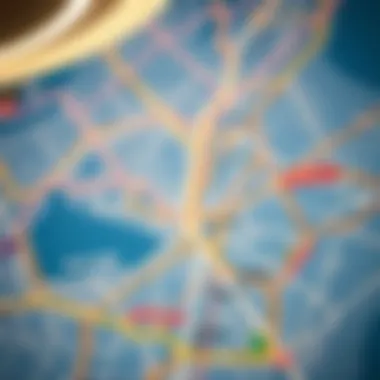

"Innovations are the lifeblood of modern transport systems, intertwining efficiency, safety, and sustainability."
For more information on Dubai's Metro innovations, you can visit Wikipedia or check out Dubai's Roads and Transport Authority.
Neighborhood Connectivity
The significance of neighborhood connectivity cannot be overstated when discussing urban environments, particularly in a sprawling metropolis like Dubai. The metro system plays a pivotal role in linking various neighborhoods, thus fostering not just transportation but also community interactions and accessibility to essential services. Enhanced connectivity transforms how residents navigate their city while also influencing where they choose to live, work, and spend leisure time.
Metro and Urban Development
Dubai's metro system is not just a means of transport; it’s a catalyst for urban development. Streets and avenues bustling with life evolve around metro stations. As properties near metro lines become highly coveted, developers often flock to these areas, recognizing the increase in demand. Consequently, this supports higher-density developments that make urban living more viable.
The expansion of the metro creates a ripple effect in urban planning, leading to the design of pedestrian-friendly spaces, mixed-use developments, and green areas. The integration of metro lines with urban design ensures that residents can enjoy more than just transit convenience but also a variety of recreational and commercial amenities nearby.
Linking Key Destinations
Key destinations in a city like Dubai play a critical role in shaping commuter choices and lifestyle convenience. Connecting these hubs seamlessly is vital for both residents and visitors. The metro's design has been intuitive in this regard, aiming to provide easy access to the most frequented areas.
Business Districts
The business districts in Dubai, such as the Dubai International Financial Centre, thrive on connectivity. By having metro stations in such locations, businesses enjoy a broader talent pool, since employees can commute without the hassle of traffic jams, which are notoriously prevalent in the city. This makes business districts an attractive choice for professionals looking to maximize their time and productivity.
One key characteristic of these districts is their strategic placement relative to metro lines. Visibility and accessibility increase foot traffic, greatly benefiting retail establishments and dining options. However, the influx of businesses can lead to a competitive marketplace, driving up rental prices. The crucial aspect remains in ensuring that this economic vitality translates into sustainable living conditions for residents.
Tourist Attractions
Tourist attractions significantly contribute to the appeal of Dubai as a global destination. The metro efficiently connects iconic sites such as the Burj Khalifa and the Dubai Mall, allowing tourists easy access without the need to navigate through traffic or parking challenges. This enhances the visitor experience and encourages longer stays, benefiting the local economy.
The unique feature of these attractions is their ability to draw not just local tourists but also international visitors. The metro serves as a vital tool to promote tourism as well versed in economic growth, supporting ancillary services—hotels, restaurants, and shops. Although the influx of tourists can sometimes overwhelm local resources, ongoing planning aims to balance this demand sustainably.
Residential Areas
Residential areas adjacent to metro stations notably increase in attractiveness. The ease of transportation can significantly influence property buyers, making such neighborhoods appealing for families and young professionals. The characteristic of these areas is their blend of convenience and community; residents enjoy quick access to work and recreational spots without sacrificing the quiet suburban feel.
One of the unique advantages of these residential areas is that they often offer enhanced amenities such as parks, schools, and retail, further elevating their value. However, as demand escalates, it can lead to potential overcrowding and rising living costs that must be managed meticulously to maintain quality of life.
In summary, the integration of Dubai's metro with neighborhoods serves as a vital thread in the fabric of urban life. It creates opportunities while also posing challenges that the city must navigate to ensure sustainable growth and livability.
Economic Implications of the Metro
The economic implications of Dubai's metro system are profound and multifaceted, extending far beyond the mere provision of transportation. This section delves into how the metro plays a key role in reshaping both the real estate market and the overall economic landscape of the city. The metro's influence on property prices, investment boost, and development prospects showcases its significant contribution to Dubai's urban fabric.
Effect on Property Prices
The metro's presence has a direct correlation with property prices in Dubai. Areas adjacent to metro stations often witness an uptick in property values. This trend is attributed to the enhanced accessibility and convenience that the metro offers to potential buyers and renters. The proximity to a metro station can significantly affect the desirability of a neighborhood, leading to:
- Increased demand for residential properties
- Higher rental yields for landlords
- A vibrant commercial atmosphere that attracts businesses
For example, neighborhoods like Dubai Marina and Jumeirah Lake Towers have seen property prices surge, driven largely by their close access to metro stations. Investors keen on capitalizing on these opportunities should keep a close eye on upcoming developments around new metro lines. It's where the rubber meets the road for discerning property enthusiasts.
Investment Opportunities
The metro not only influences prices but creates a web of investment opportunities across various real estate sectors, encouraging both local and foreign investors to take the plunge.
Commercial Real Estate
The rise of metro stations often sparks a surge of demand for commercial real estate. Businesses seek locations that offer easy access to transportation, giving them an edge in attracting customers and employees alike. Areas like downtown Dubai, which are serviced by the metro, are becoming hotbeds for new offices and retail spaces. The key characteristic of commercial real estate in relation to the metro is its potential for high foot traffic. This attracts retailers, cafes, and even co-working spaces, making it a popular choice among investors. However, while the returns can be substantial, high initial investment and market volatility are risks that should not be overlooked.
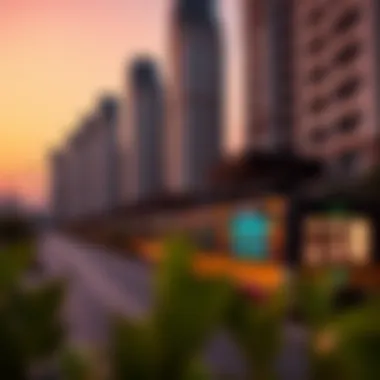

Residential Development
Residential development also benefits tremendously from the metro's expansion. Developers are increasingly focusing on building residential units near metro stations, recognizing that many buyers are prioritizing accessibility. A notable example is the development of high-rise apartments near the Business Bay metro station, catering to a growing population of workers and families. The unique feature of these residential units is their blend of modern amenities and proximity to a major transportation hub. This blend can drive prices up and offer high rental yields but sometimes can lead to an oversupply if not carefully managed.
Long-term Value Appreciation
Finally, long-term value appreciation is another area where the metro's influence is evident. Properties located near metro stations are often viewed as safer investments since they are less likely to lose value compared to those in less accessible areas. The uplift in property values over time is a compelling argument for investors looking for stability amid fluctuating market conditions. As the metro system expands further, the anticipation of future value addition could entice buyers. However, prospective investors should be cautious and conduct thorough market research to avoid pitfalls in this dynamic landscape.
"Investing in properties near metro stations is not just about location; it’s about making a smart decision for long-term growth."
Challenges and Future Developments
The evolution of Dubai’s metro system is a remarkable feat of urban engineering, yet it faces hurdles that must be addressed for continued growth and service enhancement. Understanding these challenges is critical in the context of urban mobility and economic vitality. It provides insights into how infrastructure can adapt to meet rising demands and evolving populations. The future developments planned aim to tackle current limitations while enhancing the system's role as a linchpin in Dubai's transportation network.
Current Limitations
Capacity Issues
A prominent issue facing Dubai's metro system is its capacity. As the city swells with expatriates and tourists alike, the number of daily passengers continues to escalate, often pushing the system to its limits. Train cars designed for high-density travel become overcrowded during peak hours, leading to discomfort and dissatisfaction among commuters.
This bottleneck not only affects the daily commuter experience but also has implications for the overall efficiency of the transportation network. Effectively addressing capacity issues could lead to a significant increase in user satisfaction and reliability in transit. One unique feature of this challenge is the need for a balance between accommodating more passengers and maintaining service quality.
On the other hand, some may argue that these capacity issues reflect the metro's popularity, as more people choose public transport over private vehicles, helping to ease road congestion. However, without forward-thinking solutions, such as increasing train lengths or frequency, the situation may worsen.
Service Frequency
Linked closely with capacity is the aspect of service frequency. In simple terms, the time between trains can make or break a rider's experience. A higher frequency means shorter wait times and more flexibility for passengers, while infrequent service can lead to longer, frustrating commutes.
Currently, service frequency varies throughout the day, which means during peak hours trains might run frequently, but in off-peak times, the wait could stretch longer than ideal. This inconsistency often leaves commuters feeling uncertain about their travel plans. Moreover, ensuring consistent service frequency is a logistical dance — it requires a precise orchestration of resources to meet varying demands throughout the day.
The daunting task here involves assessing demand accurately and adjusting services accordingly while crafting a schedule that is both sustainable and economically viable. Although optimizing service frequency poses operational challenges, the potential for increased ridership makes it a necessary consideration for the future of the metro.
Plans for Expansion
New Lines Under Construction
While challenges exist, there’s also a forward-thinking approach in the works. New lines are currently under construction, marking a significant development in Dubai’s urban landscape. Expanding the metro line infrastructure plays a vital role in alleviating the existing pressures on the system. The newly planned routes are designed to connect densely populated areas and business hubs, creating a more integrated transport solution.
This expansion isn't merely about stretching the existing system; it's about redefining connectivity. New lines mean more commuter options and increased accessibility, bridging gaps in the transit network and ensuring that underserved areas become part of the urban fabric. However, construction always comes with its own host of challenges, including budget concerns and the need to minimize disruptions to current services.
Enhancements to Existing Stations
Another key area of focus lies in the enhancements to existing stations. As Dubai's metro system matures, modernizing current stations is essential for improving the overall commuter experience. Potential upgrades might include better facilities, improved signage, and enhanced services, which altogether make for a more user-friendly system.
Moreover, as usage grows, it is important to ensure that existing stations can handle increased foot traffic without becoming bottlenecks. Enhanced stations will also contribute to the aesthetic and functionality, creating a more inviting atmosphere. A unique characteristic of these enhancements is that not only are they geared towards operational efficiency but they also aim to make public transportation more appealing, which can attract even more users.
Cultural Impact of the Metro
The cultural influence of Dubai's metro system stretches far beyond mere transport. It acts as an artery of social interaction and opportunity, effectively weaving a rich tapestry of experiences that connect the diverse population of this dazzling city. As an emblem of modernity, the metro system not only aids in commuting but also fosters a sense of community among its riders. The interplay of cultures onboard the trains makes for a unique microcosm, exemplifying the blend of traditions and backgrounds that Dubai encompasses.
Social Dynamics Among Commuters
When you step onto a metro train in Dubai, you're joining a moving congregation of individuals, sometimes from all walks of life, who might not otherwise cross paths. It's this unlikely juxtaposition that creates a vibrant social atmosphere and presents challenges too.
- Community Building: As people share a common space during their daily travels, casual conversations bloom between commuters. These brief interactions can lead to friendships, collaborations, or at the very least, an appreciation for one another's experiences. For instance, someone might share tips on local dining, while another might network for professional growth.
- Diversity in Culture: The rich mix of nationalities aboard the metro is palpable. From East to West, you can hear different languages, observe varied attire, and witness a fusion of customs. This not only enriches daily commutes but also enhances cultural understanding within the community.
However, the crowded nature of the trains can sometimes lead to tension. Rush hours expose the fragility of patience when space is scarce. Many commuters will often find themselves elbow-to-elbow, testing their personal bounds as they navigate this urban riding experience.
In a way, these shared trials can also strengthen bonds—as the old adage goes, "misery loves company". This sense of shared experience often translates into more understanding and camaraderie among daily travelers.
Public Perception and Acceptance
Public perception of the metro system is double-edged. While many celebrate its efficiency, aesthetic design, and practicality, others grappling with its constraints can exhibit mixed feelings. The truth is, acceptance plays a pivotal role in determining how well the metro integrates into Dubai's fabric.
- Adoption Rate: Since its inception, the metro has transcended mere transport mechanisms, becoming an essential part of daily life. Recent surveys indicate that a staggering percentage of residents perceive the metro as a reliable alternative to other transport modes like taxis or personal vehicles. However, there’s always room for improvement.
- Feelings of Safety and Security: Efficient measures have been implemented to ensure the safety of passengers, but public sentiment can vary. Individuals might feel more secure traveling during daylight hours, with concerns regarding safety during late-night rides. Public trust relies massively on consistent safety protocols and interactions with staff.
- Cultural Representation: The metro stations often showcase the art and culture of the Emirates, creating a sense of belonging and pride. Murals and installations narrate stories that resonate with the populace’s heritage, bridging the gap between the hustle and bustle of modern life and cultural nostalgia. It's this tangible connection to culture that enhances the acceptance and embrace of the metro within the community.




